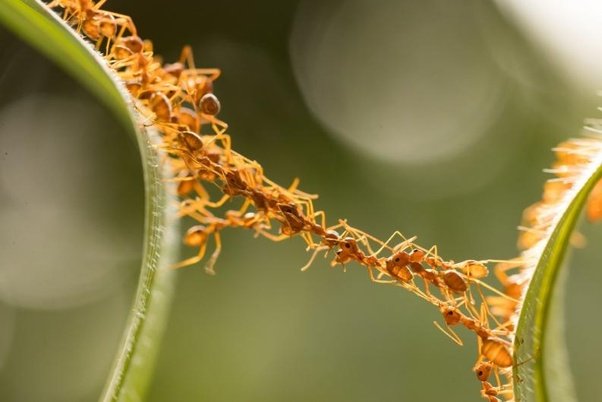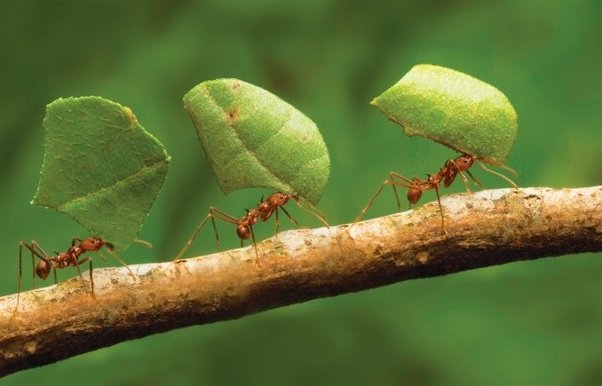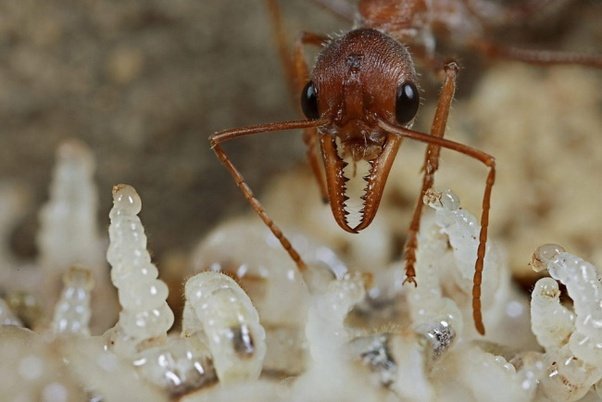What are some of the special adaptations of ants that fascinate science?
I do not know if these facts fascinate science but they fascinate me, hehehe.
They are as old as the dinosaurs
Anthropologists estimate that Homo sapiens (modern humans) have been on Earth for about 200,000 years. That is only a fraction of the age of the Earth, which is about 4540 million years old. The first humans evolved ("Homo") from australopithecines ancestors about 2 million years ago. This period of time makes the ants much older than humanity. Scientists estimate that the ants evolved in the mid-Cretaceous period, which was an amazing 110 to 130 million years ago. Consequently, human beings are only babies on planet Earth compared to ants.
The hive mind of ants

The ants come together to form a huge and coordinated "superorganism". Just as human beings are able to function because of all the different organs that make up their body, so do individual ants as parts of a larger organism. There are a series of individual parts (ants) that fit together to cooperate and achieve incredible feats. Instead of working as individuals, they function as parts of a collective whole, doing what is best for the colony as a collective. For example, a swarm of ants works together to select the ideal location for the hive, while a single ant can make an error. Ants are able to do this by the way they communicate (as we will see later). They "speak" in such a way that they form a seamless structure, similar to the brain.
The communication system of the ants

Ants are able to communicate and collaborate effectively by using chemical substances known as "pheromones." Through these chemicals, ants are able to send simple messages to their peers, alerting of any danger or indicating when the food has been located. Workers release pheromones with specific messages to say things like: "I'll show you where the food is or" Danger, look behind you "(Well, so the latter would really be a bit more like" Intruder, alert! !)
In this sense, the individual members of an ant colony are able to "talk" to each other in order to coordinate their efforts by means of their antenna to smell the chemicals that other ants release. As a result, this is a faster and more efficient way of communicating.
Ants have slaves

Ants may look like simple creatures, but they have actually evolved well and form complex societies (with an ant queen and everything). There are several species of ants that attack neighboring colonies in order to steal the eggs or larvae and take them to their own colonies. This is a practice known as "dulosis." Of course, these young ants acquired by force do not always become slaves. Sometimes they are used as a source of food (they are eaten). Species that use dulosis are informally called "slave-making ants," and many of the ant species that use this practice do so in order to support their colonies.
The queen ant lives for a long time
In comparison to a human being, ants are only on the planet for a short time. Many species only live a few weeks. However, some ants can live for years. In fact, many queen ants can live for decades (the oldest recorded ant lived for an astounding 30 years).
Megalopolis
The largest ant colony in the world was discovered in 2002. This super colony has millions of ants that live in millions of anthills. It has an extension of 3 600 miles, from Italy to the northwest of Spain.
Always on the right
It is not known why, but when the insecticide sprays, ants tend to fall always to the right.
Ants that sacrifice for the colony
There are certain species of ants, which use their worker ants as a barrier to entry to the colony, that is, they use their heads to hermetically cover the entrance of the burrow, to prevent intruders from entering.
Living nest
Every so often, hundreds of thousands of legionary ants embark on an emigration that devastates everything that gets in their way. On the trip they transport the eggs and during the stops they huddle together to form a living nest, created by their own bodies. Inside, the queen rests safely.
Learning by imitation
Many animals can learn behaviors by imitation, but it is possible that ants are the only group, apart from mammals, in which an interactive teaching has been observed. An experienced harvester of Temnothorax albipennis leads an inexperienced companion to a newly discovered food source through the extremely slow process of so-called "tandem recruitment". The "student" ant gets knowledge from its "tutor". Both the tutor and the student recognize how their partner's progress is going, making the tutor go slower when the student stays behind, and accelerate when the student gets too close.
Step counter
Desert ants (Cataglyphis fortis) carry a built-in pedometer to make sure they always find their way back home. German scientists at the University of Ulm discovered a decade ago that these insects have an internal step counter, integrated into their nervous system, which is "reset" each time they return to the nest. Moreover, they have measured their steps so well that if their legs are shorten or lengthen they make mistakes estimating the distance traveled.
Other ants sacrificed for the good of the colony
I do not say that they like to have to do it, but if necessary, the ants sacrifice members of their colony if the common good requires it.
For example, they sacrifice wounded ants that, in addition to suffering, can be a burden on the colony. On the other hand, it is known that certain species of ants work hard to secure and seal the anthill at night. To do this, groups of about 10 ants come out, shielding the entrance with branches, stones and other elements of the environment ... even knowing that they will not be able to return and that will mean their death that night, surely.
Improvised raft
Red ants are known to be able to create living rafts to be transported by water. Holding each other they create tough but lightweight structures that allow them to cross watery terrains without danger.
Ants emit sound
If you want to survive as an ant, you'd better prepare to make noise. A new study shows that even ant pupae (a stage between larvae and adults) can communicate through sound and that this communication can be crucial for their survival.
These types of ants have a specialized spike along their abdomen that strike with one of their hind legs, similar to dragging the teeth of a comb along the edge of a board. This seemed to indicate that this noise served mainly as an emergency beacon, allowing the ants to "scream" for help when threatened by a predator.
Using an extra-sensitive microphone that picked up the weak acoustic signals, the researchers measured the sounds produced by 10 different larvae of scabrinodis, 6 immature pupae and 6 mature pupae. While the immature larvae and pupae were completely silent, the mature pupae produced short pulses of sound.